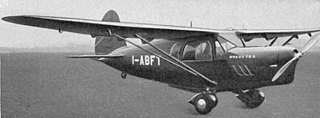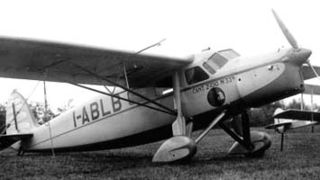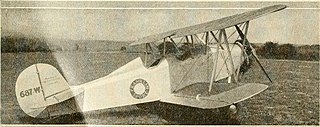Related Research Articles

The Breda Ba.79S was a single-engine four-seat high-wing private aircraft built in Italy in the late 1930s. Only a few were produced.

The Kawanishi E11K was a Japanese flying boat of the 1930s. It was designed as a night reconnaissance aircraft for the Imperial Japanese Navy, but was not accepted, the two aircraft built being used as transports as the Type 96 Transport Flying Boat during the Second World War.
The Farman F.280 was a three engine, cantilever wing monoplane designed in France as a mail carrier in the early 1930s. Underpowered and slow, only two were built and briefly used.
The Kawanishi K-11 was a 1920s Japanese single-seat carrier fighter designed and built by the Kawanishi Aircraft Company to meet an Imperial Japanese Navy requirement. The type did not enter service and only two prototypes were built.

The CANT Z.1010 was a single engine, five seat Italian passenger aircraft flown in the mid-1930s. Only one was built.

The Tachihi R-53 was amongst the first aircraft built in Japan after the relaxation of the ban imposed at the end of World War II. It is a parasol-wing, two seat, training aircraft powered by a British engine. Only one was produced.

The Kawanishi K-8 Transport Seaplane was a Japanese single-engined floatplane of the 1920s. Seven were built in 1926 and 1927, and were used to operate airmail services.
The Hollandsche Vliegtuigenfabriek Avia was a two-seat biplane, designed and displayed in the Netherlands in 1918. It was advertised as a fighter or as a post and passenger aircraft. Its first flight has not been confirmed.

The LFG V 60 was a small, single engine, tandem seat floatplane training aircraft, designed and built in Germany in the mid-1920s. About five were constructed.
The Bloch MB.90 was the first all-metal French light aircraft. Only two aircraft were completed, making their first flights in 1932, though there were several variants.
The Renard R.33 was a Belgian training aircraft with aerobatic capability. Two were flown in 1934 but no more were produced.
The Medwecki and Nowakowski M.N.3 or just M.N.3 was a low-powered, four seat, Polish aircraft flown in 1928. The sole example was modified into a more powerful two-seater which served aeroclubs until World War II.

The Franklin Sport is a two seat sport and training biplane built in the U.S. in 1930. Several different engines, in the power range 55–90 hp (41–67 kW), were fitted. Two remained airworthy in 2011.

The Hiro H3H1 or Navy Type 90-1 Flying boat was a Japanese flying boat bomber built in 1931. It was the first large all-metal aircraft built in Japan. Only one was completed.
The Kawanishi K-10 Transport was a 1920s Japanese passenger and mail transport. Two were built, one briefly serving a route between cities in Japan, Korea and China.

The Kawanishi K-6 was a passenger-carrying biplane floatplane, built in Japan in the 1920s. The sole example took part in an around Japan flight then flew as a transport with Japan Aviation.
The sole Kawanishi K-2 was the first specialized Japanese racing aircraft. The advanced, Junkers-influenced, single seat monoplane's first flight was in the late summer of 1921. It had a promisingly high maximum speed but a career limited by numerous minor accidents produced no victories or records.
The Kawanishi K-3 was a Japanese, fast, multi-purpose civil transport aircraft from the early 1920s. Despite its good performance it was eclipsed by the release of Army surplus machines and only one was built.
The Itoh Emi 16 Fuji-go (Fuji), built in 1920, was intended as a cheap and simple general purpose civil biplane but gained publicity with exhibition flights and successful speed and altitude contests against higher-powered fighter aircraft.
The Fukunaga Tenryu 10 was the largest Japanese civil passenger aircraft when it first flew in 1922. Its passenger cabin seated four.